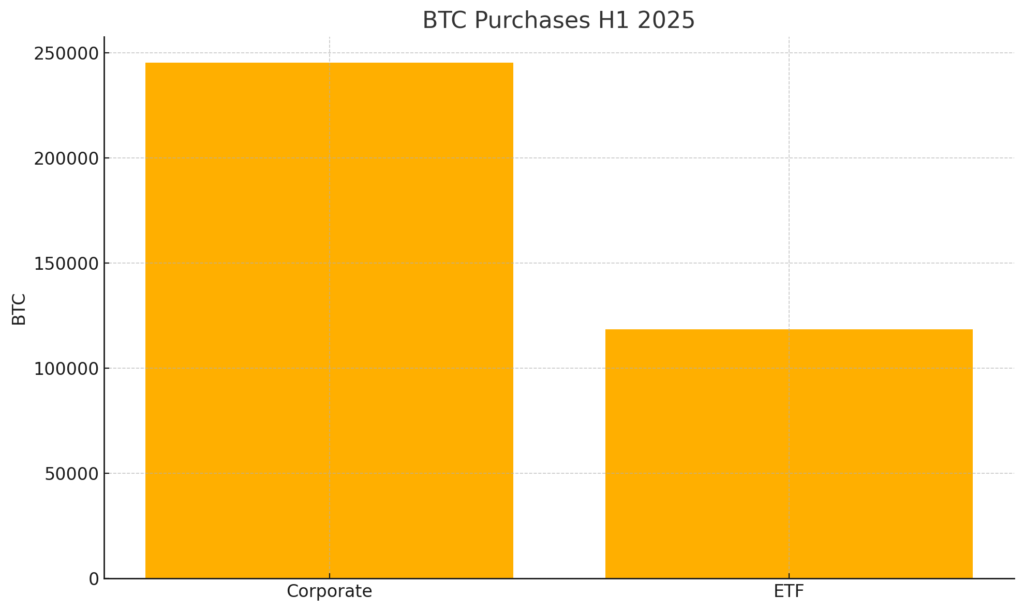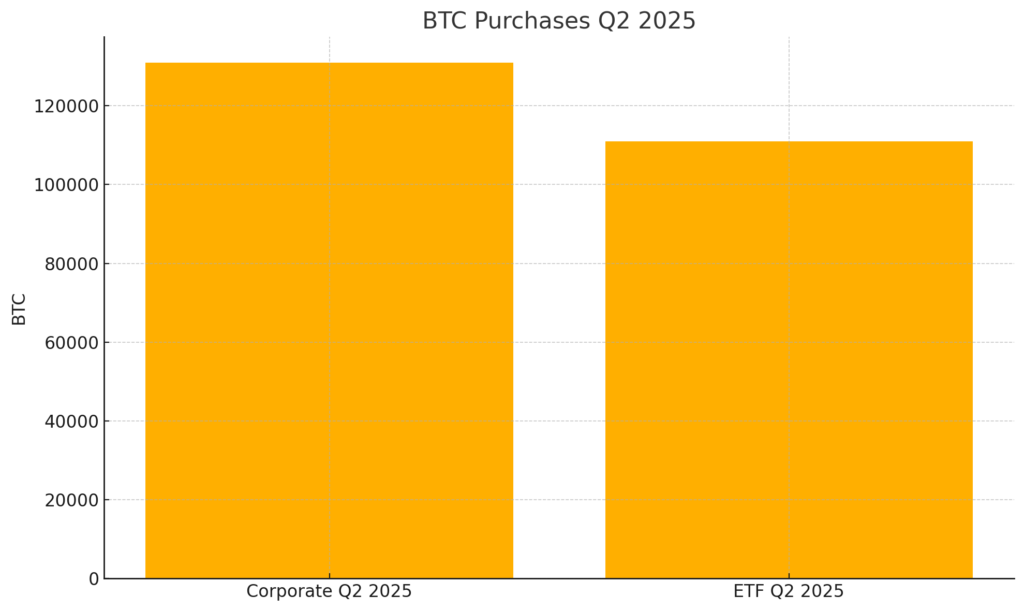
Main Points:
- Corporate vs. ETF Purchases (H1 2025): Public companies bought 245,510 BTC, more than double the 118,424 BTC acquired by spot ETFs.
- Year-over-Year Growth: Corporate BTC holdings jumped 375% from 51,653 BTC in H1 2024; ETF inflows fell 56% over the same comparison.
- Q2 2025 Trends: Public companies added ~131,000 BTC (up 18% QoQ), while ETFs grew by ~111,000 BTC (up 8%).
- Diverse Corporate Buyers: MicroStrategy’s (now Strategy Inc.) share of corporate purchases fell from 72% to 55%, indicating broader adoption.
- Strategic Rationales: Inflation hedging, cross-border liquidity, brand alignment with digital finance, and long-term treasury diversification.
- Market Impact: If the trend continues, corporates may become the dominant marginal buyers, tightening available supply and influencing price formation.
- Financial Leverage Concerns: Many firms finance BTC purchases via debt instruments, raising balance-sheet risk considerations.
1. Introduction: From Speculation to Strategic Reserve
In the first half of 2025, a remarkable shift unfolded: publicly traded companies amassed nearly 246,000 BTC, outpacing spot Bitcoin ETFs by more than two to one. Once viewed chiefly as a speculative asset, Bitcoin is now gaining recognition at boardroom tables as a strategic treasury reserve. This article delves into the data, examines driving factors, and explores implications for market dynamics and corporate finance.
2. Data Overview: Quantifying the Divergence
- Total Corporate Acquisitions (Jan–Jun 2025): 245,510 BTC, a 375% rise from 51,653 BTC in H1 2024.
- Total ETF Inflows (Jan–Jun 2025): 118,424 BTC, a 56% drop from the previous year .
- Corporate-to-ETF Ratio: Approximately 2.1:1 in favor of corporates.
- Chart 1: BTC Purchases H1 2025 by Corporates vs. ETFs (above).

Clearly, corporate treasuries are absorbing Bitcoin at unprecedented rates, while ETF demand—which largely reflects retail and hedge-fund flows—has cooled since the initial post-launch frenzy.
3. Quarterly Dynamics: Sustained Corporate Momentum
Data from Bitcoin Treasuries reveals that corporates continued to outpace ETFs in Q2 2025:
- Corporate Q2 2025: ~131,000 BTC purchased, up 18% from Q1.
- ETF Q2 2025: ~111,000 BTC purchased, up 8% from Q1.
- Chart 2: BTC Purchases Q2 2025 by Corporates vs. ETFs (above).

This marks the third consecutive quarter of corporate dominance, underscoring a structural shift in Bitcoin demand.
4. Leading Corporate Buyers and Market Diversification
Previously, MicroStrategy (rebranded Strategy Inc.) accounted for as much as 72% of corporate BTC purchases. In H1 2025, its share fell to 55%, signaling that more firms are entering the market—ranging from small “zombie” companies with cash-heavy balance sheets to high-profile names like Tesla, Block, and Metaplanet. According to the Financial Times, about 130 public firms now hold roughly $87 billion in Bitcoin—3.2% of total supply—with some issuing bonds or new equity to fund acquisitions.
5. Strategic Rationales Behind Corporate Purchases
Boardrooms cite several motivations for shifting cash reserves into Bitcoin:
- Inflation Hedge: Bitcoin’s capped supply offers a potential store of value against fiat currency erosion.
- Cross-Border Liquidity: Digital assets can facilitate cheaper, faster international transfers.
- Brand Alignment: Embracing digital finance can signal innovation to customers and investors.
- Portfolio Diversification: As a non-correlated asset, Bitcoin can balance traditional holdings.
These drivers reflect a deliberate pivot from short-term speculation to long-term treasury planning.
6. ETF Landscape: Cooling Retail and Hedge-Fund Appetite
While spot Bitcoin ETFs remain major holders—approximately 1.4 million BTC combined—they have seen inflow rates diminish from their January 2024 debut highs. Institutional filings show hedge funds trimming positions amid basis trade pressures, even as advisory firms and endowments incrementally buy into ETFs.
7. Implications for Price Discovery and Market Structure
With corporates potentially emerging as the marginal buyer, Bitcoin’s price dynamics may increasingly reflect strategic treasury allocations rather than short-term trading flows. This could reduce volatility and support higher price floors, though the impact depends on whether corporate demand remains sustained or is subject to cyclical cash needs.
8. Caveats: Leverage and Balance Sheet Risks
A crucial concern is that many companies fund BTC purchases through debt—convertible notes, corporate bonds, or loans. Should Bitcoin’s price correct sharply, leveraged positions may strain balance sheets and trigger broader market sell-offs, echoing margin-call risks seen in derivatives markets .
9. Recent Developments and Outlook
- Regulatory Environment: Continued U.S. SEC oversight has not deterred new spot ETFs (e.g., BlackRock’s IBIT) from garnering inflows, with IBIT up 14% YTD amid steady demand.
- Market Valuation: Bitcoin traded near $107,000 on July 1, 2025, reflecting optimism among both traditional and digital-native investors.
Looking ahead, corporate adoption could expand if inflation concerns persist and digital transformation strategies deepen.
Conclusion: A New Chapter in Bitcoin’s Evolution
The first half of 2025 has marked a watershed moment: Bitcoin’s transformation from a predominantly speculative instrument into a strategic reserve asset for public companies. With corporations acquiring more than twice the volume of ETFs, and a diverse cohort of firms joining the trend, Bitcoin’s market structure is evolving. While this shift could foster greater price stability and institutional legitimacy, it also introduces balance-sheet considerations around leverage. As boardrooms worldwide assimilate digital assets into treasury policies, Bitcoin stands poised at the intersection of conventional finance and Web3 innovation—heralding a new era for corporate finance and the broader crypto economy.

